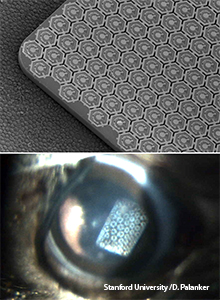
Top: PV array with 70 μm pixels on top of the retinal pigmented epithelium in the eye of a rat. Bottom: Photovoltaic array with 140 μm pixels implanted under the retina.
Researchers at Stanford University (U.S.A.) say a new type of retinal prosthesis may someday restore sight in patients with degenerative eye conditions like retinitis pigmentosa and age-related macular degeneration. Daniel Palanker and colleagues reported their use of a pulsed near-infrared (NIR) laser and video goggles to activate photovoltaic (PV) chips implanted under the retinas of blind rats (Nature Com., 4, 1980).
The system attains video images from a camera, then processes the scene and uses a pulsed 910-nm laser to project it by video goggles into the eye. The image projected on to the PV implants is converted into pulses of electric current which activate retinal neurons. The researchers found that this retinal stimulation elicited robust cortical responses in the brain similar to visually evoked potentials.
The PV chips are much like those used in solar-power modules. They have advantages over other approaches to retinal prosthetics, including high pixel density, wireless signaling and modular design. The small dimension of the arrays (30 μm x 1 mm) greatly simplifies the surgery, compared to other implant designs that are wired to extraocular power supplies.
Despite the long road ahead, the results show that the NIR irradiation needed for the implant activation will not damage eye tissue. “After several years of development and testing our technology in vitro and in vivo,” says first author Yossi Mandel, “we are very encouraged by the recent animal results, demonstrating feasibility and great potential of photovoltaic approach to restoration of sight to the blind.”
For video animation illustrating the operation of the PV retinal prosthesis, click here.
